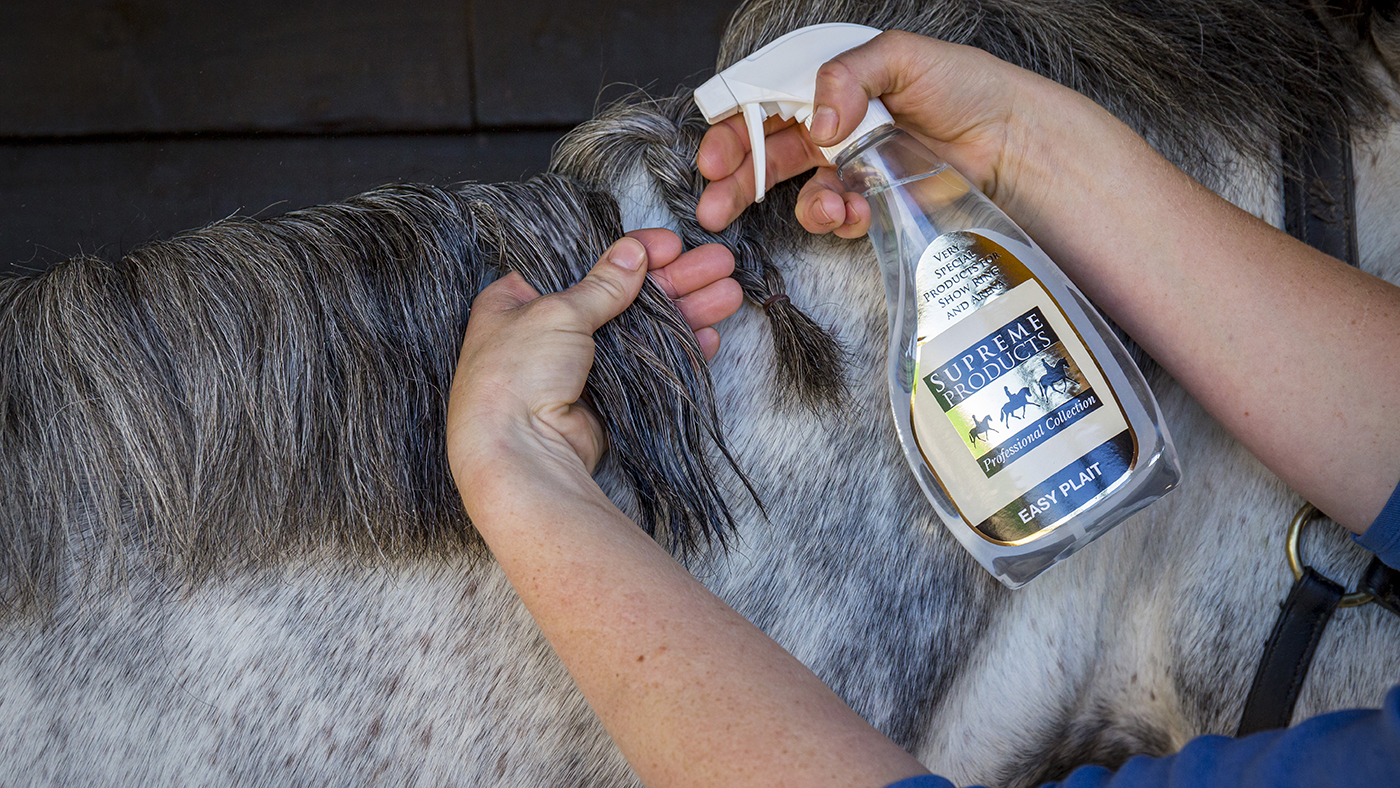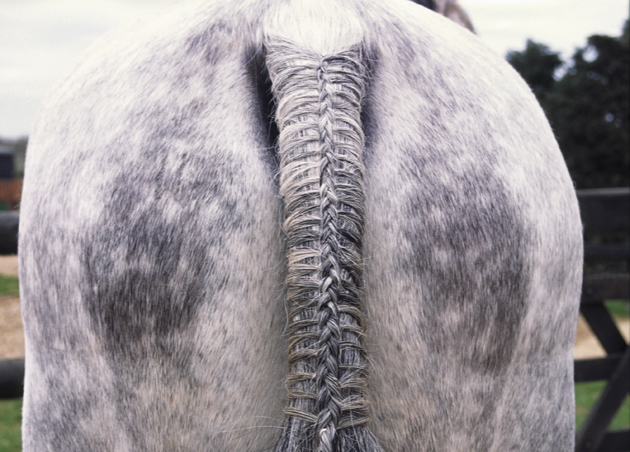In this expert guide to producing the perfect plaits that suit your horse, we outline your plaiting kit essentials, showing supremo Katie Jerram-Hunnable shares some top plaiting tips from her book Modern Horse Management, and dressage rider Sarah Millis demonstrates how she plaits her dressage horses in an exclusive video
Top show horse producer Katie Jerram-Hunnable says knowing how to plait a horse’s mane to make the animal appear at their best is an art, as the number of plaits and the way they are set on to the neck can help maximise the horse’s conformation. It can even create an optical illusion, as when setting plaits on top of the neck adds the appearance of extra substance to a neck lacking muscle.
Plaits can be sewn or, if you are practising techniques or in a hurry, fastened with rubber bands or yarn. Stitching looks neater and will keep the plaits more secure. To undo stitched plaits, use a dressmaker’s stitch unpicker rather than scissors as there is less risk of cutting into mane hair.
Conventional (hunter) plaits are acceptable for most disciplines, with the proviso that some showing categories — native ponies, pure-bred Arabs and cobs shown as traditionals — specify that manes must be natural.
Even then, it’s important to check breed and society guidelines, as some allow a degree of thinning and shortening. The rules are taken to extremes for pure-bred Arabians, where the fashion is to cut an exaggeratedly long bridlepath.
Traditionally, there were seven or nine plaits along the neck with one for the forelock. In the UK, it’s accepted that you should not need more than eleven; in the US, riders sometimes opt for many more. Tailor the size and number of plaits to suit your horse’s conformation – for some reason, most people still opt for an odd number along the neck.
A heavyweight hunter type looks better with relatively substantial plaits (not ‘golf balls’) spaced apart whilst smaller plaits set slightly closer together complement a finer type of animal.
What you need in your plaiting kit
Whether you prefer to plait your horse’s mane using a needle and thread or use rubber bands for convenience, you need a lot more than that in your plaiting kit to make the process quick and easy. Here are our recommended items for every plaiting kit:
- Waxed plaiting thread in the correct colour to match your horse’s mane
- A number of large flat needles with large eyes
- A small, sharp pair of scissors for cutting the thread into lengths
- A pack of small but strong rubber bands in a colour to match your horse’s mane – if you don’t use these to secure your plaits, then they are useful for securing the mane into equal sized sections before plaiting begins
You can, of course, also buy a complete plaiting kit.

You will also need:
- A sturdy stool of a suitable height to stand on so you can work comfortably on the mane
- A mane comb to brush the mane through and divide it into sections
- A soft brush or sponge to apply water to the mane as needed
- A plaiting gel, spray or wax to help keep the hair tidy and secure
- A clip to keep any loose hair out of the way as you work
- A stitch unpicker to remove thread from plaits afterwards
We recommend keeping your plaiting kit together in either a suitable clean plastic tub with a lid, or even better having a plaiting apron or similar you could wear around your waist, ensuring everything is kept clean, tidy and is easy to find when needed.
How to plait a horse’s mane with thread
Katie walks us step-by-step through the process she follows when plaiting her horses up for the show ring…
1. First, get everything ready and in place: it’s annoying to reach the end of a plait and realise your threaded needle is out of reach. We prefer to plait on the morning of a show, even though this may mean working in the dark. You need a brighter light than most stable lights throw, so I wear a cap with a torch attached to the brim. This allows me to focus on the precise area I’m working on. To save time, I thread lots of needles with plaiting thread the night before and keep them stuck in a small sponge so I don’t lose them. The sponge, plus some plaiting gel and a clip to hold loose mane hair out of the way as I make each plait, go in the pocket of my plaiting overalls. Once organised, the process is as follows:
2. Apply plaiting gel or, if you prefer, wet the hair and divide into even sections. Experienced plaiters can do this by eye, but it you’re unsure, section the mane and secure each section with a band or hair clip.
3. Start plaiting at the poll. If a horse becomes restless during the plaiting process, it’s easier to finish off plaits near the withers than those near his ears.
4. Divide the section into three equal, smaller ones and plait all the way down. As you plait, keep the tension taut but even. However, if you want to set each plait into a ‘hood’ of hair on top of the neck, to give an impression of more substance, don’t pull your first two crossovers as taut as the following ones.
5. Turn up the end of the plait and bind it with your knotted cotton to keep loose hairs secure.
6. Thread the needle through the base of the plait from front to back, then take the needle through the top of the plait from back to front, so the plait is doubled up.
7. Stitch down the centre, following the zigzags made by the hair sections so the stitches are hidden.
8. Take the needle from and through the bottom of the plait from front to back. Next, pass it through the top from the back to the front, so you are doubling up the plait again.
9. Stitch backwards and forwards three times to keep the plait secure. If you want to set the plait in a hood to give an impression that the neck has more substance, push it into place and hold it there as you stitch.
10. Knot the thread underneath the plait and cut it. Stand back and admire your handiwork, but don’t be tempted to pull out any stray hairs that have escaped or you’ll eventually end up with a ragged fringe along the crest.
11. If you find it difficult to make a neat forelock plait because your horse has short hairs on either side, or has a long forelock that you don’t want to shorten, make a French plait. Plait down as normal for a few turns, then take in a section of hair from each side every time you cross over.
How to plait a horse’s mane for dressage
In this video, dressage rider Sarah Millis shows how she plaits her dressage horses’ manes ready for a competition.
How to do running and Spanish plaits
Katie explains that some breeds and types of horses with long manes have too much hair to put into traditional ‘hunter’ plaits. If convention dictates that you need to plait for some competitions, such as affiliated dressage, you can make a running or Spanish plait instead. These are also useful if you need to keep a mane out of the way when riding in wet or muddy conditions.
To produce a running plait, start with a section of hair near the ears as when making an ordinary plait. Plait down, but each time you pass the left-hand section over the centre one, take in a small piece of mane. Let the mane fall naturally rather than pulling it tight and, as you progress, the plait will curve round.
Carry on plaiting, taking in the same amount of hair every time you cross the left-hand section over the centre piece. As you work, you’ll create a long plait that forms a neat edge to the bottom of the mane. When you’ve reached the withers and there’s no more hair to take in, plait the tail end and fasten as with an ordinary plait. Double up the loose ends, bind round and secure.
A Spanish plait is made using the same technique – but this time you keep the plait tight every time you take in a new section of hair. This means that the finished plait follows the line of the crest rather than curving down and round, as shown below.
How is yarn used to plait a horse’s mane?
Katie says that grooms in the US use a technique for making what they call button or rosette dressage plaits in longer manes, using yarn that is woven into the plait and tied. This is nearly as quick as using rubber bands and keeps the mane neater and more secure, though is not as neat as sewn plaits.
Start by isolating a section of mane to plait and place a piece of yarn longer than the mane hair underneath it, at the top. Divide the mane into three and pass the right section over the centre, taking the right-hand side of the yarn piece with it. Repeat with the left section, again taking the yarn with it. Plait down as far as you can, incorporating the yarn with the mane hair each time you cross over.
When you get to the bottom, tie a slip knot in the yarn to secure the plait. Make the plait itself into a knot to give you a button/rosette, pass the yarn through the hair at the top – using a tapestry needle with a large eye or dressmaker’s pull-through tool if necessary – and use the yarn to tension the plait. Tie the yarn round the top of the plait; knot and cut off the excess.
If your horse’s mane is thick as well as long, you will need to make a greater number of plaits, or you end up with unsightly ‘golf balls’.
- View Modern Horse Management by Katie Jerram-Hunnable at amazon.co.uk
You might also be interested in:

6 plaiting products to help you create the perfect look

Katie Jerram-Hunnable: 6 steps to the perfect tail plait
In her new book 'Modern Horse Management', showing supremo Katie Jerram gives a step-by-step guide to get the perfect tail

Subscribe to Horse & Hound magazine today – and enjoy unlimited website access all year round
Horse & Hound magazine, out every Thursday, is packed with all the latest news and reports, as well as interviews, specials, nostalgia, vet and training advice. Find how you can enjoy the magazine delivered to your door every week, plus options to upgrade to access our H&H Plus online service which brings you breaking news as it happens as well as other benefits.






